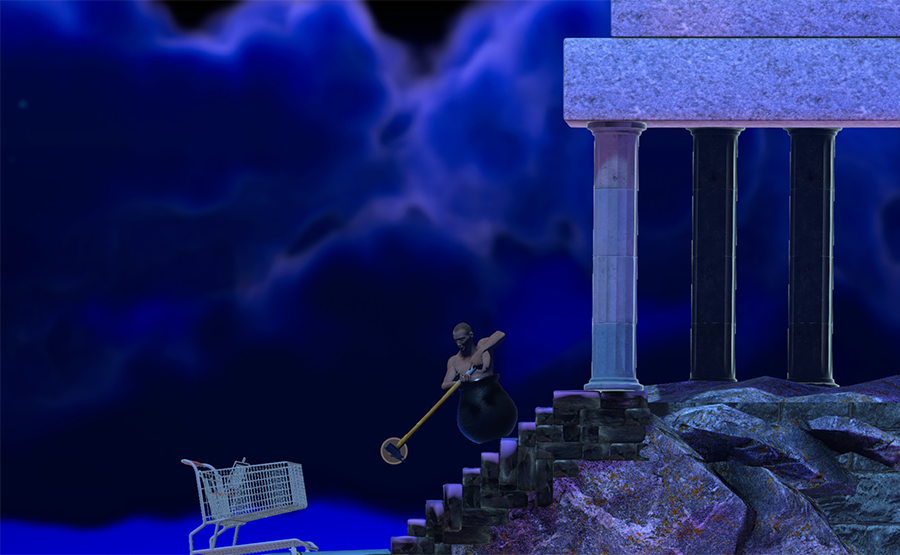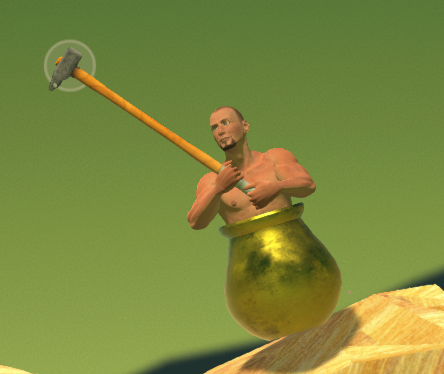The Art of Getting Over It [Review]

The shopping cart on top of the mountain.
Getting Over It with Bennett Foddy is a 2017 game about dragging yourself up a mountain of garbage and rocks commissioned by Humble Bundle and made by Bennett Foddy (creator of QWOP) for their Humble Monthly Originals program, where they make a new game every month or so for their monthly bundle subscribers. Usually they barely ever even get mentioned or played. Getting Over It is different. On the surface you’d never guess why. It’s not a very complex game, in fact, the only controls in the game are moving your mouse with one hand to swing a hammer around, and you can count all the objects that move in the game on one hand. But it’s hard. Really hard. And that makes for some good streamer content. Endless videos have been put up on YouTube or Twitch of big name personalities as well as everyone else you could imagine getting mad (or pretending to get mad) for countless hours.
But Getting Over It is deeper than that. The game itself is a metaphor. You’re not climbing a mountain. You are, in a literal sense, but more than that you have to first get over your anger at the game. Hard games are very frustrating to people, and they get very angry. Getting Over It is designed to facilitate this anger such that you need to find a way to deal with it to beat the game.
The thing about how it’s designed is that at most points in the game, you can fall from where you currently are and go all the way back to the beginning. Usually when you get angry at the game, you will start flailing or make very fast movements to try and get up the mountain faster or get back where you were faster. But this is counterproductive, since it will usually jolt you away from the cliffside and often send you right back to the start of the game or at least make you go back through the section of the mountain you just did. I had this happen many times. My first run took me about 8 hours, which seems to be about typical for the game for those that stick with it, but in those 8 hours I had to overcome getting frustrated or mad.
I started moving slower, more deliberately. Suddenly I found it was much easier to progress than before, when I would occasionally speed up. Eventually, I ended up beating the game 50 times for the achievement and discovering ways to both go fast and also not be frustrated at the game. Going past parts I used to take hours to do in a few seconds was pure catharsis for the soul. But even when going fast, you still have to master going slowly but carefully first to see real success at the game. There’s an obstacle early on in the mountain that streamers and fans call the “Devil’s Chimney”, and it’s a backwards slanted narrow passage that just has two tiny lanterns to hold onto, and it’s very easy to bang your hammer on the walls going up since they are so narrow. This is the first major challenge of the game, and one of the harder ones. But the game does this as a sort of filter, to let people without the determination to overcome the game know what they’re up against. Foddy himself said that some 40% of players never make it past this. It took me about forty minutes of trying, but it was intense and frustrating. Once I got past that, I thought I could do anything. But the mountain just got more and more ridiculous. The game says in its voiceover, done by Foddy, that most obstacles in video games are fake in that you can be confident that they can be overcome with enough time or the right equipment. And he doesn’t mean time as in getting better at the game, as this game itself can be overcome with time investment by most people. He means that a lot of games just make you grind out the win through repetitive tasks or shuttling through a story with very easy gameplay. There’s nothing inherently wrong with that, but the point here is that in this game, there’s always the doubt that you can even make it any further. I wasn’t even sure that I could beat it, even if I put the time in. A lot of the obstacles in the game are just completely ridiculous, and I was wondering if I could do it even when I was almost there. That in itself made me enjoy the experience as I was going through.

My gold-ish pot after 47 runs.
Foddy said that he wanted to make a game that didn’t care whether you beat it or not, since that type of thing probably wouldn’t get made nowadays. And what he means by that is that most games go out of their way to make it easier for the player to beat the game, they want you to succeed in the end, and to that end they have things in place that make it easier than it would be if the game were just made without the player beating it in mind. Checkpoints, leveling up, tutorials, all kinds of things. No, all games don’t have these, but many of those are older games made with the arcade mentality that games should be hard for the player to beat, since that’s what made the most quarters. We can see this transferred over to the earliest console games for quite a while. And then game designers, over time, became more and more concerned about the player’s ability to actually beat the game. But Getting Over It is more like retro games, but without coming from the mentality that games should be made to eat your money. This makes it refreshing and enjoyable, and Foddy’s commentary in the game about the way most people don’t want to be challenged anymore is interesting and engaging, and it makes you want to climb higher to hear what he’ll say next.
There’s a shopping cart at the top of the mountain and at first I thought it was just a random asset placed there because it was something to grab onto in case you start slipping off. But in his GDC talk on QWOP, titled “The Story Behind QWOP”, he says:
There’s now over 11,000 YouTube results of people playing QWOP, right, and I’ve thought about this a bit, and I’ve tried to understand why that’s the case. And I’m sure a big part of the reason is that QWOP is just like, really goofy to look at, right, I mean I’m acknowledging that, that’s a big part of the reason.
But I thought about it like this, I mean, if you ask would all those videos be there if QWOP had a high score? If it had achievements? Right? I put a high score table, a global high score table, in my iPhone version of QWOP, and you can count the fan videos for that on one hand, right so maybe that’s because the iPhone port blows, maybe it’s because it’s hard to take video of an iPhone game, but I don’t think that’s mainly it, I think people look at a global high score table and they think to themselves “well, you know, somebody’s taken care of that, right, somebody’s, somebody’s solved that”. I think you look at the high score table on Game Center on Kongregate, and it’s a bit like getting to the top of Mount Everest and finding a shopping cart that some kid’s left behind. Really it’s kind of a letdown, it’s demotivating. And I think people set their own goals, if you don’t provide official metrics of whether they’re succeeding or not. And I get letters all the time from people going “I’ve done so well in QWOP, I’ve really mastered it”.
And it looks like this, right, I mean they’re basically just crawling around on one knee. I would be ashamed to show anybody that, but people are really proud, right, they think they’ve succeeded. I think we should think about high score tables and achievements as being something that you put in for determined gamers, right, for the real kind of hardcore gamers. But you just have to understand that it takes you away from a mass appeal, it takes you away from the mass market. And I think it’s a shame that so many modern social gaming services insist on putting those features in, cause I think they can wind up being anti-social features.
This blew my mind when I heard it, it’s really profound to me, and it’s obvious this thinking is in the design of Getting Over It all throughout the game. The shopping cart is a little in-joke that hey, somebody’s already been here before and just left it sitting there, a last thing to frustrate the player if they’re in on it that you have to just learn to deal with it. But it’s funny once you know, too. And it’s much like the game as a whole. On the surface it looks intimidating, badly designed, awful, like unplayable garbage. But the more time you spend with it the more it reveals its real self to you, the more you understand it’s more about philosophy than just being a cheap, badly made Unity game.
A lot of people will dismiss this game as having bad controls, but this is just an out for the player that doesn’t feel like trying. The game’s controls are unique, and I believe they’re done this way on purpose, not simply as an homage to the game Sexy Hiking by Jazzuo as stated in the narration in-game. If Foddy had made a platformer with standard controls or many other kinds of games that have been done a lot of times already, even if it were really hard, a lot of people would still breeze through, because experience with platformers for example carries over a bit between games, and many players have played dozens or even hundreds of them and would not be that challenged by the game. This works to the game’s favor by creating as equal of a playing field as is probably possible–the control method is completely novel to almost all players of the game, which ensures the greatest number of people are challenged by it. I think this is one reason it’s just a very well executed game.
A lot of people will dismiss this game as a streamer bait game, but this would be a mistake too. It’s popular, but only kind of incidentally. Foddy never expected this game to be as popular as it is now, as most Humble Originals games are rarely played at all by many people. It just happened to do well because of how well made the game actually is, but you should definitely at least give this game a try. It changed the way I think about games a bit and it was a fun experience, I would say one of the best games of 2017 even though many people would laugh at that.
Score: 10/10



 ~50 Users Online
~50 Users Online Copyright © 2025
Copyright © 2025
Y
Yea